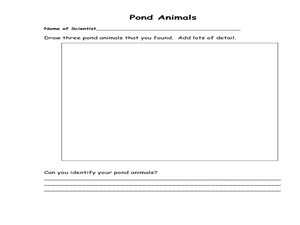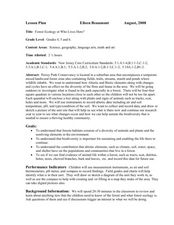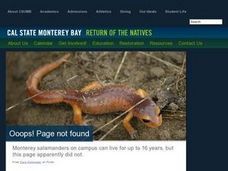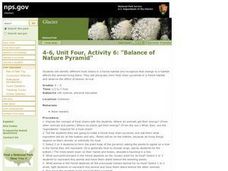Curated OER
Seed Structure and Seed Dispersal
Third graders plant seeds. In this seed structure activity, 3rd graders identify parts of a seed and plant a lima bean seed. Students discuss and reflect on the process in their journals.
Curated OER
The Secret Garden
Students explore plants in science and England as they synthesize data from the book, "The Secret Garden in this twelve lessons unit. Comparisons between the nuturing needs of plants and humans are made.
Curated OER
The Seasonal Cycle
Students complete a unit of lessons on the four seasons. They examine the effect each season has on plants, animals, and people during the actual season, read magazine and newspaper articles, and create a calendar and poster about each...
Curated OER
Pond and Pond Organisms
Students explore pond ecosystems. In this pond organism activity, students will use pond water and a plastic bad in order to locate and identify freshwater organisms. The activity is designed for younger grades, but...
Curated OER
Composting
Young scholars discover the concept of decomposition. They examine how it makes the soil more fertile and how it helps plants. They put a compost bin in their backyard and record their observations.
Curated OER
Plant Reproduction
Students investigate seeds and plant life by creating a germination chamber. In this botany lesson, students investigate the relationship between flowers and the fruit they produce while examining the structure of the flower. ...
Curated OER
PLANT PARTS WE EAT
Students identify an assortment of vegetables and learn how to locate the parts humans use for food. Students identify the plant parts we eat. Students color the pictures on their worksheets as provided. Students match the plants to the...
Curated OER
Why Are Bees Important?
Learners identify and analyze pollination and how bees play an important part in the life cycle of flowering plants. They also identify the process of plant pollination and how bees play an important part in the life cycle of flowering...
Curated OER
Watersheds and Wetlands Lesson Plan
Students study the characteristics of wetlands and watersheds. In this wetlands and watersheds instructional activity, students study the characteristics of wetlands. They investigate the plants and animals that live there and will tell...
Curated OER
Soil Profile
Fourth graders research soil layers and create a soil profile in a jar. In this soil profile lesson, 4th graders working in groups, research a given layer of soil, make a 3-5 minute presentation to the class, and complete a...
Curated OER
Dinosaur Tag
Learners review dodging, chasing and fleeing skills while reinforcing concepts about dinosaurs. They need to review the following concepts about how dinosaurs eat and move: Herbivores eat plants, carnivores eat meat, and omnivores eat both.
Curated OER
Everything in Its Place: Science Classification
Students investigate the system of classification for living things through the sixteen lessons of this unit. The five kingdoms of monerans, protists, fungi, plants, and animals form the basis of several experiments as the similarities...
Curated OER
How Does Your Plant Grow?
Students measure and record their height in centimeters on a graph. By integrating math and science, students collect data and apply graphing skills to the experiences they are having growing plants. Finally, students identify how to...
Curated OER
Forest Ecology or Who Lives Here?
Students explore a hardwood forest. In this forest ecology lesson, students examine the diversity and animals and plants as they explore their habitats at Poricy Park Conservatory. Students determine how biodiversity and abiotic elements...
Curated OER
Conserving Resources by Watering Efficiently
Students determine a watering schedule that promotes healthy grass growth. For this plants and natural resource conservation lesson, students plant grass seed in liter bottles and follow two different schedules that include "more...
Curated OER
Habitats of the World
Students complete a unit of eighteen lessons that cover climate, geography, location, plants, and animals of each of the five habitats. They are also introduced to habitat destruction and discuss ways to protect the environment. They do...
Curated OER
Invasion of the Habitat Snatchers!
Fourth graders investigate invasive plants found in a park or school environment and acknowledge the problems caused by the plants. They describe 4 methods of control of invasive plants.
Curated OER
Diversity And Adaptations Of Organisms
Seventh graders investigate how organisms respond to environmental stimuli through their behavior. They observe how plants and animals respond to varying amounts of light, water and gravity.
Curated OER
History of the Earth
Students work together in groups to research the characteristics of the Mesozoic Era. Using various sources, they must include information about climate, landforms, plants and animals found during this time period. They create a...
Curated OER
Observing Leaves and Flower Buds
Young scholars observe the first true leaves and the buds on their Brassica plants and record their observations in both words and pictures. They also observe two major developments: the true leaves and the flower buds and record their...
Curated OER
Population Explosion Relay
Learners study the concepts of seed dispersal, germination rate, exponential population growth, and predation by engaging in a bean 'weeds vs. natives' relay race. They illustrate how weeds out-compete other plants for space by crowding...
Curated OER
Balance of Nature Pyramid
Students study the concept of food chains and create a physical forest food chain pyramid. In this balance of nature pyramid instructional activity, students identify the ingredients needed on each level of the pyramid then make...
Curated OER
Become an Expert
Students practice their researching techniques by preparing a presentation with little notice. In this information research lesson, students utilize the Internet to research one of several subtopics concerning panthers....
Curated OER
Aztec Floating Gardens
Aztecs created amazing hydroponic gardens called Chinampas, to grow their crops. Learners in grades k-7 engage in four mini-experiments to understand just how amazing floating gardens are. Tip: A perfect way to bring science into your...























